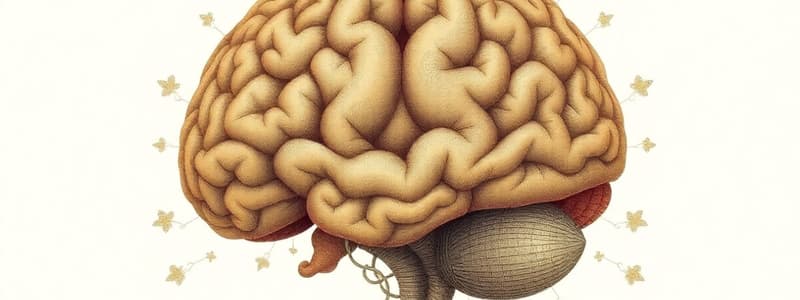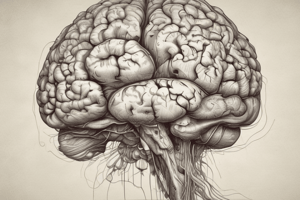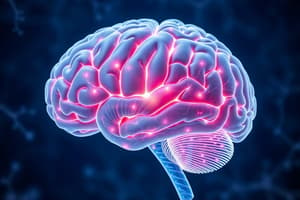Podcast
Questions and Answers
Which region of the brain is primarily responsible for coordination and balance?
Which region of the brain is primarily responsible for coordination and balance?
- Frontal Lobe
- Cerebrum
- Cerebellum (correct)
- Thalamus
What is the main function of the medulla oblongata?
What is the main function of the medulla oblongata?
- Processing sensory information
- Regulating heart rate and breathing (correct)
- Interpreting visual stimuli
- Controlling movement
Which part of the brain is involved in regulating hormones and maintaining body homeostasis?
Which part of the brain is involved in regulating hormones and maintaining body homeostasis?
- Corpus Callosum
- Pons
- Cerebral Cortex
- Hypothalamus (correct)
In the spinal cord, which section primarily contains the nerves that direct movement to the limbs?
In the spinal cord, which section primarily contains the nerves that direct movement to the limbs?
What is the primary function of the thalamus in the brain?
What is the primary function of the thalamus in the brain?
Which lobe of the brain is primarily responsible for processing auditory information?
Which lobe of the brain is primarily responsible for processing auditory information?
What are the main components of the hindbrain?
What are the main components of the hindbrain?
Which injury is most likely to result in paralysis or loss of sensation below the site of injury?
Which injury is most likely to result in paralysis or loss of sensation below the site of injury?
Flashcards
Cerebrum
Cerebrum
The largest part of the brain, responsible for higher cognitive functions such as thinking, learning, and memory.
Cerebellum
Cerebellum
Located at the back of the brain, it coordinates movement, balance, and coordination.
Cerebral Cortex
Cerebral Cortex
The outermost layer of the cerebrum, responsible for complex functions like language, reasoning, and sensory perception.
Corpus Callosum
Corpus Callosum
Signup and view all the flashcards
Pons
Pons
Signup and view all the flashcards
Medulla Oblongata
Medulla Oblongata
Signup and view all the flashcards
Thalamus
Thalamus
Signup and view all the flashcards
Hypothalamus
Hypothalamus
Signup and view all the flashcards
Study Notes
Brain Basics
- The brain is part of the central nervous system.
- The brain controls many bodily functions.
- The average human brain weighs about 3 pounds.
- The brain can be divided into two hemispheres.
- Each cerebral hemisphere is divided into four lobes (frontal, parietal, temporal, and occipital)
- Sulci are grooves in the brain.
- Gyri are folds in the brain.
- The folding of the brain increases its surface area.
Regions of the Brain
| Regions | Location | Function |
|---|---|---|
| Cerebrum | Largest part of the brain | Higher-level functions, like thinking, learning, and memory |
| Cerebellum | Located at the back of the brain | Coordination of movement, posture, and balance |
| Cerebral Cortex | Outer layer of the cerebrum | Higher-level thinking and processing, sensory perception |
| Corpus Callosum | Bundle of nerve fibers connecting the hemispheres | Communication between the two hemispheres |
| Pons | Structure connecting the cerebrum w/ other parts | Relays signals between various parts of the brain |
| Medulla Oblongata | Lower part of the brainstem | Control of involuntary functions like breathing, heart rate, and digestion |
| Thalamus | Located in the center of the brain | Relay station for sensory information |
| Hypothalamus | Located below the thalamus | Regulates hormones, body temperature, and other body processes |
| Pituitary Gland | Located beneath the hypothalamus | Produces hormones that regulate various bodily functions |
| Brain Stem | Composed of the midbrain, pons, and medulla | Control of basic body functions, regulates consciousness |
Spinal Cord Basics
- The spinal cord is part of the central nervous system.
- Spinal nerves are attached to the spinal cord.
- The spinal nerves are divided into different sections.
- There are many pairs of spinal nerves leaving the spinal cord.
- Dorsal roots carry sensory information.
- Ventral roots carry motor information.
- The spinal cord is protected by bony structures.
CNS Injuries
- Brain and spinal cord injuries can have significant effects.
- The brain is protected by protective layers in the skull.
- Damage to the brain stem can cause life-threatening issues.
- Different protective measures protect the delicate brain.
Studying That Suits You
Use AI to generate personalized quizzes and flashcards to suit your learning preferences.




